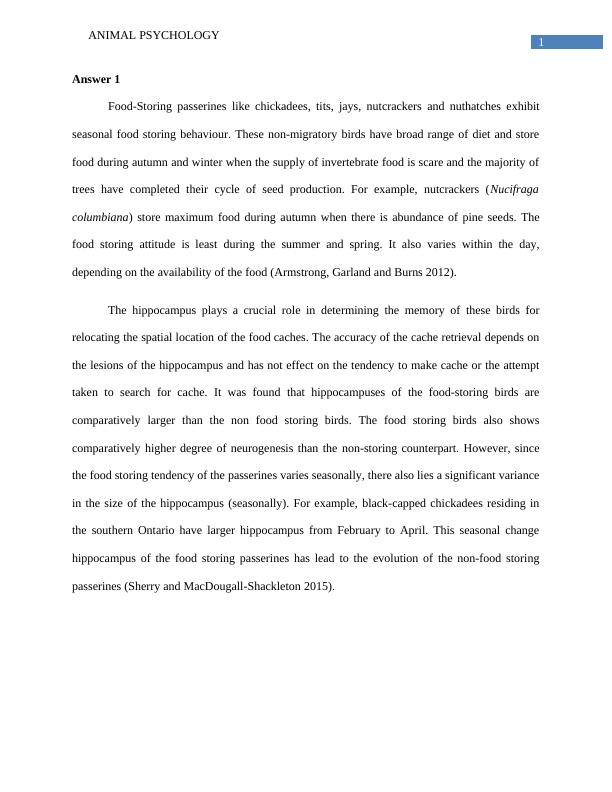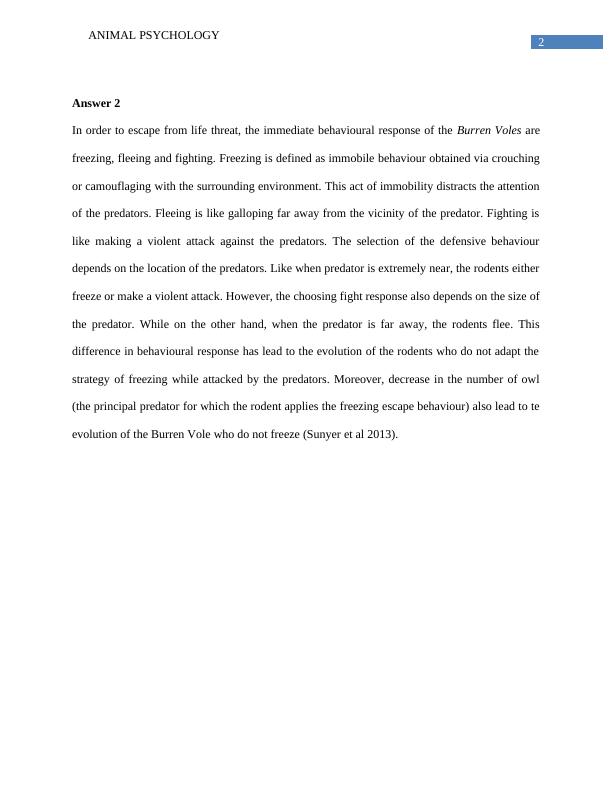Ask a question from expert
Animal Psychology | Assignment
6 Pages1143 Words447 Views
Added on 2019-11-25
Animal Psychology | Assignment
Added on 2019-11-25
BookmarkShareRelated Documents
Running Head: ANIMAL PSYCHOLOGYAnimal PsychologyName of the StudentName of the UniversityAuthor note

1ANIMAL PSYCHOLOGYAnswer 1Food-Storing passerines like chickadees, tits, jays, nutcrackers and nuthatches exhibitseasonal food storing behaviour. These non-migratory birds have broad range of diet and storefood during autumn and winter when the supply of invertebrate food is scare and the majority oftrees have completed their cycle of seed production. For example, nutcrackers (Nucifragacolumbiana) store maximum food during autumn when there is abundance of pine seeds. Thefood storing attitude is least during the summer and spring. It also varies within the day,depending on the availability of the food (Armstrong, Garland and Burns 2012).The hippocampus plays a crucial role in determining the memory of these birds forrelocating the spatial location of the food caches. The accuracy of the cache retrieval depends onthe lesions of the hippocampus and has not effect on the tendency to make cache or the attempttaken to search for cache. It was found that hippocampuses of the food-storing birds arecomparatively larger than the non food storing birds. The food storing birds also showscomparatively higher degree of neurogenesis than the non-storing counterpart. However, sincethe food storing tendency of the passerines varies seasonally, there also lies a significant variancein the size of the hippocampus (seasonally). For example, black-capped chickadees residing inthe southern Ontario have larger hippocampus from February to April. This seasonal changehippocampus of the food storing passerines has lead to the evolution of the non-food storingpasserines (Sherry and MacDougall-Shackleton 2015).

2ANIMAL PSYCHOLOGYAnswer 2In order to escape from life threat, the immediate behavioural response of the Burren Voles arefreezing, fleeing and fighting. Freezing is defined as immobile behaviour obtained via crouchingor camouflaging with the surrounding environment. This act of immobility distracts the attentionof the predators. Fleeing is like galloping far away from the vicinity of the predator. Fighting islike making a violent attack against the predators. The selection of the defensive behaviourdepends on the location of the predators. Like when predator is extremely near, the rodents eitherfreeze or make a violent attack. However, the choosing fight response also depends on the size ofthe predator. While on the other hand, when the predator is far away, the rodents flee. Thisdifference in behavioural response has lead to the evolution of the rodents who do not adapt thestrategy of freezing while attacked by the predators. Moreover, decrease in the number of owl(the principal predator for which the rodent applies the freezing escape behaviour) also lead to teevolution of the Burren Vole who do not freeze (Sunyer et al 2013).

End of preview
Want to access all the pages? Upload your documents or become a member.